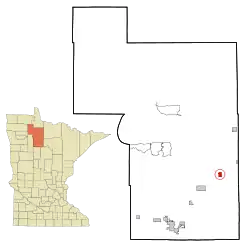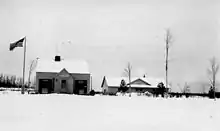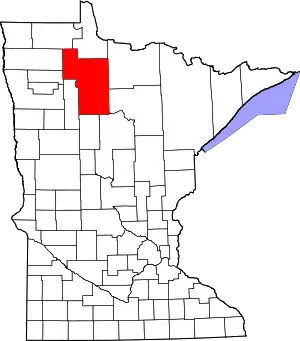Blackduck, Minnesota
Blackduck is a city in Beltrami County, Minnesota, United States. The population was 785 as of the 2010 census.[7] It is located 24 mi (39 km) northeast of Bemidji.
Blackduck | |
|---|---|
| Motto(s): "A Great Place For Families"[1] | |
 Location of Blackduck, Minnesota | |
 Blackduck Location in the United States | |
| Coordinates: 47°43′49″N 94°32′52″W | |
| Country | United States |
| State | Minnesota |
| County | Beltrami |
| Government | |
| • Mayor | Max Gulette |
| Area | |
| • Total | 1.65 sq mi (4.27 km2) |
| • Land | 1.61 sq mi (4.16 km2) |
| • Water | 0.04 sq mi (0.10 km2) |
| Elevation | 1,398 ft (426 m) |
| Population | |
| • Total | 785 |
| • Estimate (2019)[4] | 833 |
| • Density | 518.36/sq mi (200.08/km2) |
| Time zone | UTC-6 (Central (CST)) |
| • Summer (DST) | UTC-5 (CDT) |
| ZIP codes | 56630, 56663 |
| Area code(s) | 218 |
| FIPS code | 27-06256[5] |
| GNIS feature ID | 0655419[6] |
| Website | http://www.blackduckmn.com/ |
History
The village of Blackduck was organized in October 1900, and the town was incorporated on December 21, 1900.[8] The first settlers of this community came from Crookston, Minnesota. The town was founded because of the great logging potential of the area. The Continental Divide is located near the area, and provided good drainage which resulted in good logging because the land was not wet. The community was named for Blackduck Lake.[9]
Geography
According to the United States Census Bureau, the city has a total area of 1.71 square miles (4.43 km2), of which 1.67 square miles (4.33 km2) is land and 0.04 square miles (0.10 km2) is water.[10]
Demographics
| Historical population | |||
|---|---|---|---|
| Census | Pop. | %± | |
| 1910 | 942 | — | |
| 1920 | 788 | −16.3% | |
| 1930 | 704 | −10.7% | |
| 1940 | 753 | 7.0% | |
| 1950 | 732 | −2.8% | |
| 1960 | 765 | 4.5% | |
| 1970 | 595 | −22.2% | |
| 1980 | 653 | 9.7% | |
| 1990 | 718 | 10.0% | |
| 2000 | 696 | −3.1% | |
| 2010 | 785 | 12.8% | |
| 2019 (est.) | 833 | [4] | 6.1% |
| U.S. Decennial Census[11] | |||

2010 census
As of the census[3] of 2010, there were 785 people, 338 households, and 185 families living in the city. The population density was 470.1 inhabitants per square mile (181.5/km2). There were 372 housing units at an average density of 222.8 per square mile (86.0/km2). The racial makeup of the city was 89.4% White, 0.4% African American, 4.6% Native American, 0.5% Asian, 0.1% Pacific Islander, 0.8% from other races, and 4.2% from two or more races. Hispanic or Latino of any race were 2.0% of the population.
There were 338 households, of which 32.8% had children under the age of 18 living with them, 33.1% were married couples living together, 16.9% had a female householder with no husband present, 4.7% had a male householder with no wife present, and 45.3% were non-families. 41.1% of all households were made up of individuals, and 22.1% had someone living alone who was 65 years of age or older. The average household size was 2.22 and the average family size was 2.97.
The median age in the city was 37.1 years. 27.1% of residents were under the age of 18; 9.3% were between the ages of 18 and 24; 23.1% were from 25 to 44; 19.6% were from 45 to 64; and 20.9% were 65 years of age or older. The gender makeup of the city was 45.9% male and 54.1% female.
2000 census
As of the census[5] of 2000, there were 696 people, 304 households, and 175 families living in the city. The population density was 465.8 people per square mile (180.4/km2). There were 324 housing units at an average density of 216.8 per square mile (84.0/km2). The racial makeup of the city was 92.10% White, 0.86% African American, 3.45% Native American, 0.14% Asian, 0.14% from other races, and 3.30% from two or more races. Hispanic or Latino of any race were 0.72% of the population.
There were 304 households, out of which 26.0% had children under the age of 18 living with them, 40.1% were married couples living together, 14.5% had a female householder with no husband present, and 42.4% were non-families. 37.8% of all households were made up of individuals, and 19.7% had someone living alone who was 65 years of age or older. The average household size was 2.14 and the average family size was 2.81.
In the city the population was spread out, with 24.6% under the age of 18, 9.1% from 18 to 24, 22.0% from 25 to 44, 15.8% from 45 to 64, and 28.6% who were 65 years of age or older. The median age was 40 years. For every 100 females there were 68.9 males. For every 100 females age 18 and over, there were 64.1 males.
The median income for a household in the city was $21,848, and the median income for a family was $29,750. Males had a median income of $28,594 versus $16,838 for females. The per capita income for the city was $12,536. About 11.6% of families and 16.9% of the population were below the poverty line, including 18.5% of those under age 18 and 15.8% of those age 65 or over.
Parks and recreation
Camp Rabideau is located six miles south of Blackduck. The camp is one of the 2,650 camps President Franklin D. Roosevelt opened during his New Deal Program. The camp is a National Historic Landmark, and is well preserved. The camp was opened to give jobs to young men between the ages of 17 and 21 in hopes of helping the country get out of the Great Depression.[12]
Blackduck Golf Course is located one mile west of Highway 71. This is a nine-hole course with cart rental provided. The golf course is located near the public access to Blackduck Lake. Pine Tree Park is just a short walk from the lake access. This is the closest camp ground to Blackduck. Blackduck Lake has numerous resorts that surround the lake.[1]
Education
Blackduck has one public school which houses Blackduck Elementary School and Blackduck High School.[13]
Businesses
There are several establishments in Blackduck that serve food. These places include Hillcrest Supper Club, Countryside Restaurant, Timberline, and the Blackduck Bowling Alley, which are all are located off of Highway 71. Hungry Duck Restaurant is located on Main Street. The Pond is on Frontage Road. Blackduck Family Foods is the town's grocery store. The town has two hotels. The Drake Motel is located across the street from The Pond, and the AmericInn is located on Highway 71.
The largest employer in Blackduck is the window treatment factory called Anderson Fabric's Workroom.
People Who Live/Lived There
Helen Anderson (1976-1986) Roy Anderson (1976-1986) D.A.A. And L.E.A. (1973-Present) U.S.A. (1974-1992) Colleen Balsiger (1990-2012) Rolland Anderson (2015-2017) M.M.J. (1945-????,Aft.2015-Present
Newspaper
- The Blackduck American
References
- "City of Blackduck Minnesota". City of Blackduck Minnesota. Retrieved October 14, 2012.
- "2019 U.S. Gazetteer Files". United States Census Bureau. Retrieved July 26, 2020.
- "U.S. Census website". United States Census Bureau. Retrieved 2012-11-13.
- "Population and Housing Unit Estimates". United States Census Bureau. May 24, 2020. Retrieved May 27, 2020.
- "U.S. Census website". United States Census Bureau. Retrieved 2008-01-31.
- "US Board on Geographic Names". United States Geological Survey. 2007-10-25. Retrieved 2008-01-31.
- "2010 Census Redistricting Data (Public Law 94-171) Summary File". American FactFinder. U.S. Census Bureau, 2010 Census. Retrieved 23 April 2011.
- "Area History". Blackduck Area History & Art Center. Retrieved October 14, 2012.
- "Profile for Blackduck, Minnesota, MN". ePodunk. Retrieved October 14, 2012.
- "US Gazetteer files 2010". United States Census Bureau. Archived from the original on 2012-01-25. Retrieved 2012-11-13.
- "Census of Population and Housing". Census.gov. Retrieved June 4, 2015.
- "Camp Rabideau National Historic Landmark". United States Department of Agriculture Forest Service. Retrieved October 14, 2012.
- https://web.archive.org/web/20090416050250/http://blackduck.k12.mn.us/
